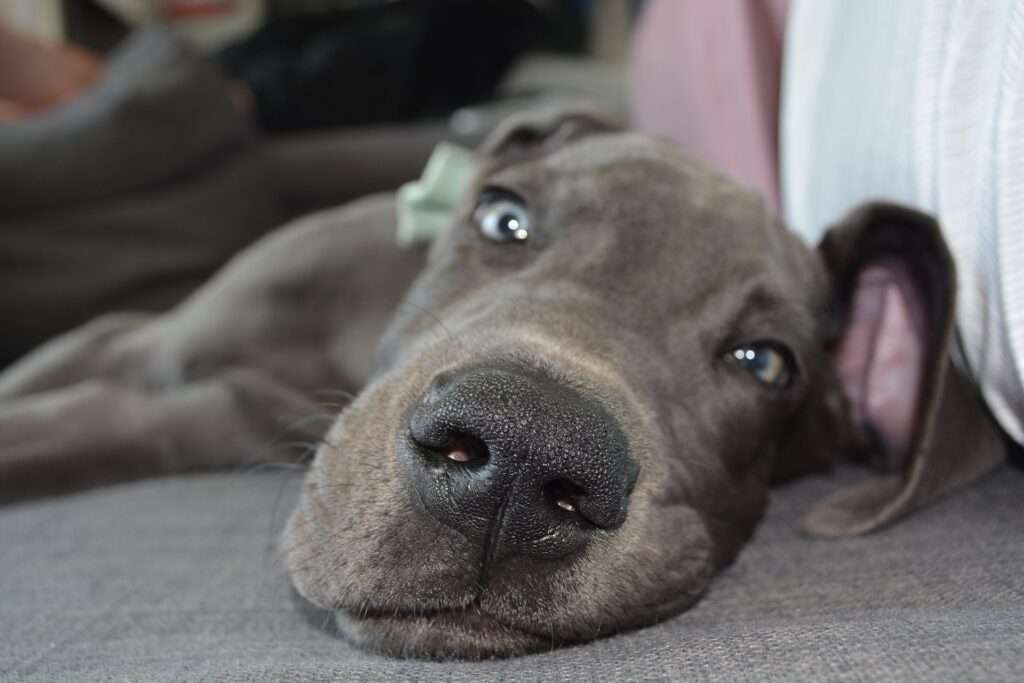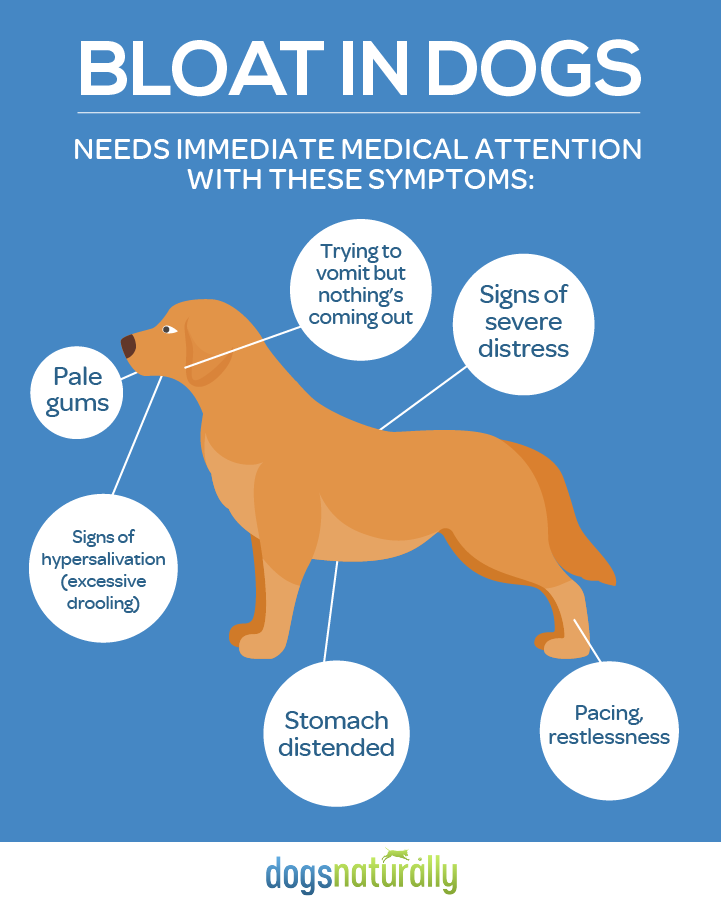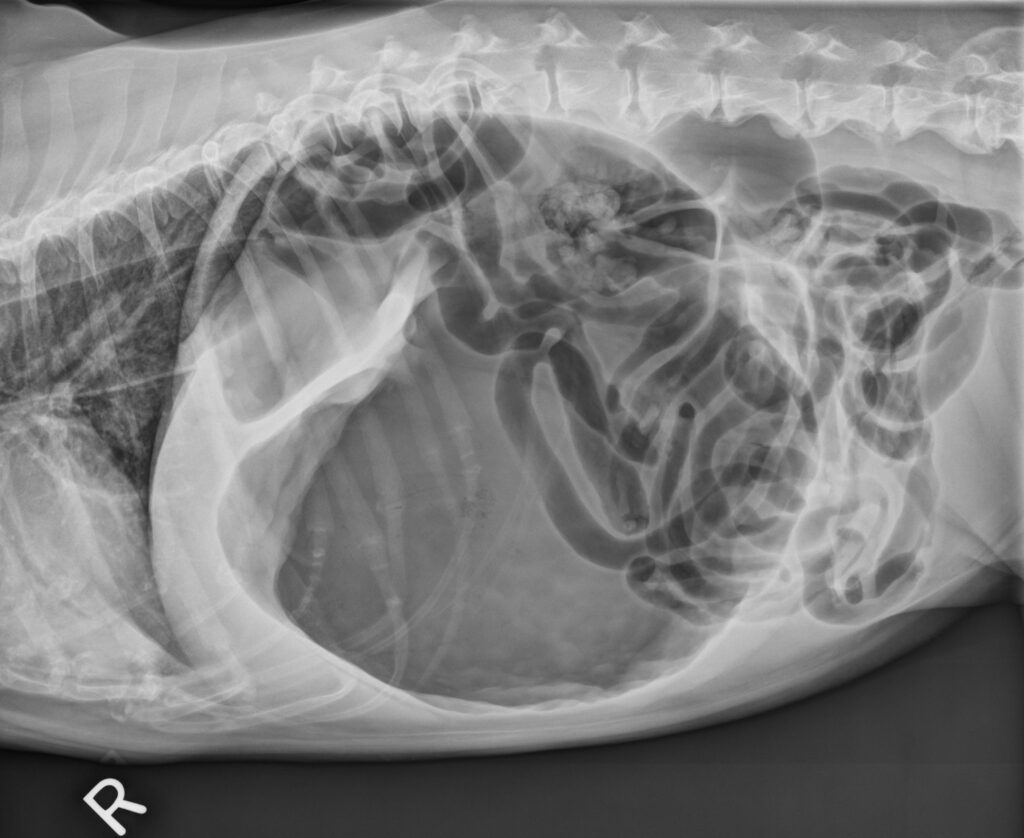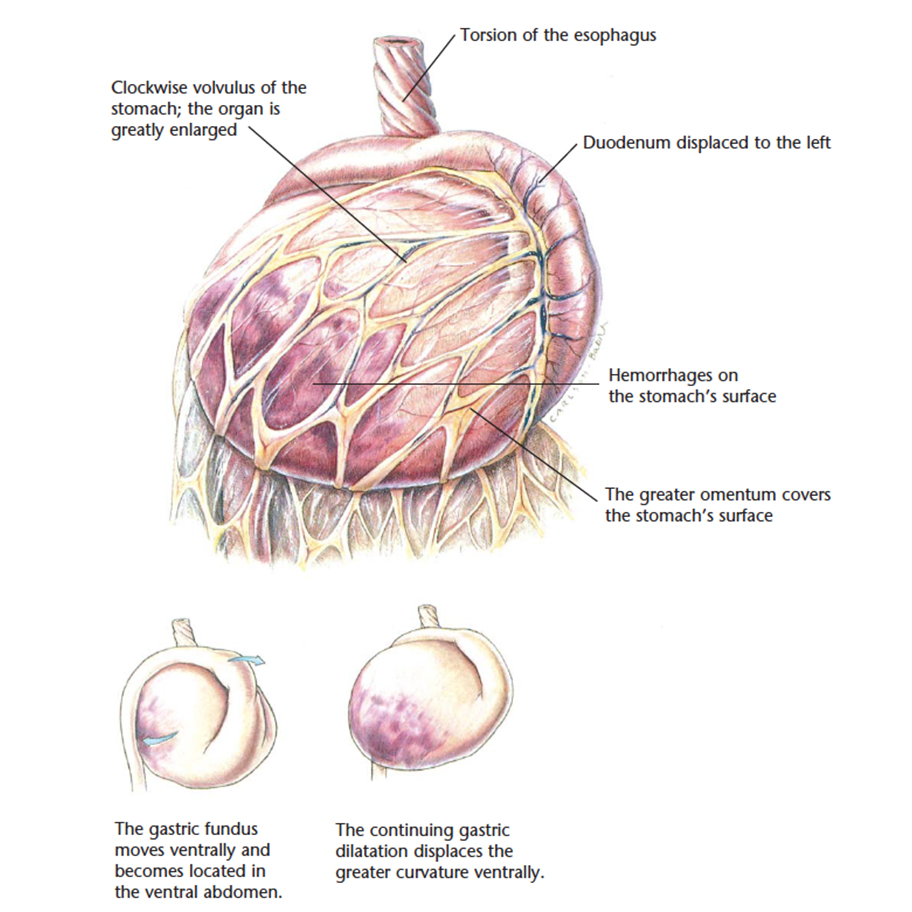Gastric dilatation-volvulus (GDV), commonly referred to as gastric torsion or “bloat”, is a serious condition, fatal if left untreated. The stomach becomes severely distended with gas, fluid or food, which puts pressure on the surrounding organs and decreases blood flow to and from these organs. When the stomach twists, it completely obstructs the blood supply to major organs and can impact blood flow throughout the body, resulting in shock. As the stomach expands, it puts pressure on several large arteries and veins. Blood supply is cut off to the stomach, toxic products build up, and tissues begin to die. GDV develops without warning and can progress quickly. It’s always an emergency as every minute without treatment increases the risk of further damage and, ultimately, death.


Is My Dog At Risk?
Dogs with deep chests are most at risk, ie. Those that are much taller than they are wide create a high’ height to width ratio’. Examples are Great Danes, Shepherds, Pointers, Mastiffs, Rottweilers, Boxers and Greyhounds. Among the smaller breeds, Shar Peis, Basset Hounds and Dachshunds are most commonly affected. However, the condition has been reported in nearly all breeds and types of dogs, so every dog owner needs to be aware of the potential causes and symptoms and have an action plan in place in an emergency.
Besides having a deep chest, the following may also predispose a dog to bloat:
- Eating very quickly
- Overeating
- Drinking a large quantity of water in a short space of time
- Exercising after eating
- Raised food bowls
- Stress/anxiety
- Genetic factors


Signs of Bloat and Treatment
Due to the severity of GDV and the speed at which it develops, it is vital to be on the lookout for the following signs of trouble to act quickly:
- Restlessness
- Pacing
- Distended, swollen abdomen
- Painful abdomen
- Overall distress
- Retching and attempts to vomit without success
- Drooling
- Panting or rapid breathing
- Collapse – inability to stand
If your dog experiences the above symptoms, rush him to the vet immediately, as every minute is critical. Dogs with GDV who do not receive treatment will not survive. However, up to 80% of dogs receiving prompt treatment for the condition survive.
Without torsion (twisting of the stomach), it may be possible to treat the dog without surgery, usually by means of a stomach pump, under anaesthetic. This removes the accumulated gas, fluid and or food and alleviates pressure.
In the event of a torsion, surgery is imperative to untwist the stomach and return it to its appropriate position. Generally, a gastropexy is also performed – the stomach is stitched to the abdominal wall to prevent it from twisting in the future. (Unfortunately, once bloat has occurred, it will commonly occur again.) The surgery also allows the veterinarian to assess the amount of damage caused by the lack of blood flow due to the twisted stomach. If there is any damaged tissue, it will be removed. (Due to the high risk of complications during and after surgery, and the need for intensive monitoring, if our vets at CVC assess the patient to have a GDV, referral to our closest Specialist and Emergency Centre, VSOS, will be advised.)
In cases where the condition has been left untreated for a longer time period, there may be too little live tissue to salvage. Diagnostic testing beforehand can usually indicate whether surgery would be high-risk and the likelihood of success. Euthanasia would sadly be the only alternative to alleviate suffering.


Prevention of Bloat
While there can be no guarantees, there are ways to minimise the risk of bloat:
- Divide the daily total food recommendation into several smaller meals rather than feeding one or two large ones.
- Feed a complete and balanced veterinarian-recommended diet – these are more nutritionally dense, meaning smaller portions can be fed than poorer quality food, where much larger volumes are required to provide enough nutritional value.
- If a raised food bowl is indicated (for improved digestion and to reduce stress on the neck and back), ensure that the bowl is never placed higher than at the level where your dog’s legs join his body.
- Never allow a dog to drink a large amount of water in one go.
- Avoid exercise on a full stomach.
- A preventative gastropexy may be considered if your dog is high-risk – many owners of large and giant breeds elect to do this procedure when their dog is young. It can be performed at the same time as desexing, often using keyhole (laparoscopic) surgery, which is minimally invasive. This ensures that should bloat occur; the stomach would not twist and result in a potentially life-threatening condition. We would happily advise if you’d like to discuss this option; click here to get in touch with us. (For large and giant breeds, we generally recommend desexing a bit later when the dog is more mature. We refer this desexing and gastropexy combination surgery to our specialist referral centre, VSOS.)


Surgery and post-operative care for GDV are costly, and euthanasia is the only alternative to prevent dog suffering. There is no conservative or “wait and see” approach to preventing pain, suffering, and eventual death. For those who own high-risk breeds, budgeting for a preventive gastropexy rather than risking an expensive emergency surgery with an already compromised pet is certainly something to think about – research pet insurance options and see whether this procedure would be covered or whether all or part of the treatment would be covered in the event your dog suffered a gastric torsion.
No pet parent wants to be caught by surprise with GDV – being informed and prepared in advance is your best defence and your dog’s best chance at survival.
